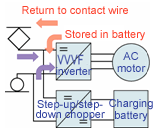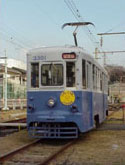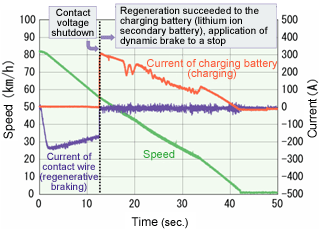|
To enable use of the charging battery (a lithium ion secondary battery) developed for power-recycle EMUs in 1,500V DC EMUs, the RTRI developed a power converter (a step-up/step-down chopper) that can be installed on existing EMUs, and an algorithm to control it (Fig. 1). This has enabled hybrid control to run EMUs using power supplied through contact wires and from the onboard charging battery (Fig. 2). As a result, the power generated in braking is stored in the onboard battery when it cannot be returned to the contact wire. This substantially decreases cancellation or narrowing-down of the regenerative brake.
The RTRI tested a 1,500V motor up to 100km/h at its rolling stock test plant and performed a running test of 750V test tram cars at 50km/h in its compound. The aim was to check their behavior at the shutdown and recovery of contact wire voltage in powering and regenerative braking under hybrid control. The RTRI also tested the powering and regenerative braking performance of the tram cars at the upper limit of contact wire voltage, behavior when the pantograph is reduced or raised, and other response characteristics in abnormal situations. Results demonstrated that electric energy that could not be returned to the contact wire was stored in the onboard charging battery, and that tram cars accelerated or decelerated smoothly (even in abnormal situations) with power supplied by the contact wire or from the charging battery (Fig. 3). In the running test in the compound, the brake energy recovery rate was about 70% when brakes were applied at 50km/h.
Consequently, when a charging battery corresponding to the regenerative brake narrowing-down in relevant sections is installed, it has become feasible for EMUs to significantly reduce the cancellation of the regenerative brake. The effective utilization of regenerated power to save energy, improve the reliability of the regenerative brake and reduce activation of the mechanical brake are expected to lead to labor savings in the maintenance of brake shoes and wheels.

Fig. 1 Flow of power supplied by contact wire and charging battery under a hybrid control system | 
Fig. 2 Hybrid-type test car | 
Fig. 3 Results of the test on hybrid control at the rolling stock test plant (in generative braking) |
HOME > Major Results of Research and Development in Fiscal 2004 > IV Harmonization with the environment

RTRI HOME
Copyright(c) 2005 Railway Technical Research Institute,Tokyo Japan, All rights reserved.
|


